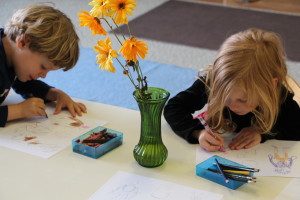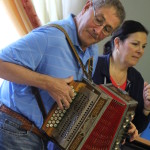This week, I gave my students a visual lesson on drawing random objects in the studio. Since we’ve been talking about geometric solids, we took some time to talk first about the objects. This helped them to begin recognizing that many objects around us consist of different geometric solids. Everyone caught on quickly, for example, when I held up an apple, several kids called out, “sphere,” and I when I held up a mug, many said, “cylinder.” Then I held up objects that could be made from more than one geometric solid. For example, I showed a vase that started off narrow at the bottom and widened at a top like a funnel. I placed a cylinder next to the narrow part, and a cone next to the top for the kids to recognize that these shapes could be seen here. And the most complex of all was when I had a student stand next to me, and I asked what solids could a person be made of? Some said her head was like an “ovoid,” and some said no, an “elipsoid.” I said, maybe it’s somewhere in the middle… I picked up a pencil and drew each of the objects that I had talked about earlier, as quickly as possible, only drawing the most basic shapes that I talked about. I even drew the student, pointing out other basic shapes, like a cylinder-shaped neck and so forth. I explained that these were sketches that will help me to begin building more realistic and detailed drawings. Then, I took a dark colored pencil such as purple and slowly began outlining my sketches, making minor changes to sharpen the image. Finally, I begin adding the details such as the patterns in a vase and facial features on the girl. At the end of the day, the entire class took some time refining some sketches that I had printed out for them on paper. They added the detail and made them as creative and abstract as they preferred. It was a really fun experiment that got kids thinking about the 3D forms all around them. On top of that, it was a great review for recognizing their geometric solids.










